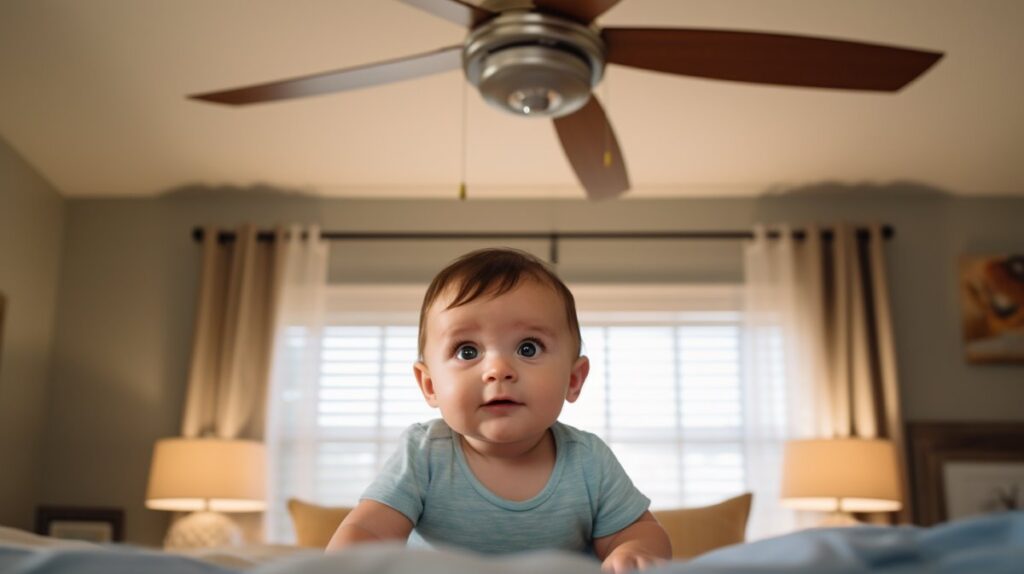Why Do Babies Like Ceiling Fans? Exploring the Fascination
Ceiling fans seem to have a mesmerizing effect on babies. As soon as they see one, their eyes light up, and they become fixated on it. But why do babies like ceiling fans so much? As a parent of many little tots, I’ve often wondered about this myself.
- Why Do Babies Like Ceiling Fans? Exploring the Fascination
- Understanding Infant Vision
- ChatGPT said:
- The Role of Ceiling Fans in a Baby's Room
- Safety Concerns and Precautions
- Possible Signs of Autism
- Other Reasons Babies Stare at Ceiling Fans
- Common Misconceptions and Final Thoughts
- Final Thoughts: Safety First
- Frequently Asked Questions
- 1.) What is it about ceiling fans that babies find fascinating?
- 2.) Can staring at ceiling fans be a sign of autism in babies?
- 3.) Why do some babies seem to be obsessed with ceiling fans?
- 4.) Is it normal for a 2-month-old baby to stare at a ceiling fan?
- 5.) Can having a ceiling fan on be harmful to a baby?
- Using a ceiling fan safely can help keep the nursery cool, comfortable, and soothing for your baby.
- 6.) What are some ways to safely incorporate ceiling fans in a baby's room?
One theory is that babies are drawn to the movement of the fan blades. The spinning motion of the blades can be mesmerizing to babies, especially if they are still learning to focus their eyes. Another possibility is that the sound of the fan provides a soothing white noise that can help babies fall asleep or calm down.
Whatever the reason, it’s clear that ceiling fans have a special appeal to babies.
Why Do Babies Like Ceiling Fans? Exploring the Fascination
The Fascination of Babies with Ceiling Fans
Many parents notice how quickly a baby can become mesmerized by a ceiling fan. Babies are naturally drawn to movement, and a fan’s gentle rotation can capture their attention for surprisingly long stretches of time. For a young mind that’s still learning how the world works, something as simple as spinning blades feels new, interesting, and calming.
Limited Attention Span
Babies don’t have long attention spans, but they can lock onto something that truly interests them. A ceiling fan offers:
- A steady, repetitive motion
- Something new to focus on in the room
- A simple pattern that doesn’t overwhelm their senses
Because it’s different from toys or faces they typically see, a fan becomes a fresh source of stimulation.
Visual Perception: Contrasts, Colors, Moving Objects
Newborns have very limited vision at first. They see best at about 8 to 10 inches away, and everything else appears blurry. As their eyesight develops, they become more sensitive to contrast and motion. A ceiling fan provides exactly that:
- Dark blades against a lighter ceiling
- Smooth, predictable movement
- Easy-to-track visual patterns
Watching a fan can help babies practice tracking movement with their eyes, which is an important part of visual development.
A Subtle Help with Temperature Regulation
Beyond visual interest, a fan can also help keep the room comfortable. A gentle breeze helps prevent overheating, which is important for safe sleep and overall comfort. While the air movement isn’t the reason babies stare, it can still play a helpful role in the environment.
Motion and Cognitive Development
Babies also learn by watching how objects move. Even though a ceiling fan is not interactive, the repetitive rotation can stimulate parts of a baby’s developing brain. Observing motion helps build early cognitive skills such as:
- Pattern recognition
- Visual tracking
- Understanding cause and effect (they begin to expect the movement)
Babies love ceiling fans for a simple reason: they offer calming, repetitive motion with high contrast and gentle sensory input. This combination supports early visual development, holds a baby’s attention, and contributes to a soothing environment. What looks like a small fascination is actually part of how babies learn about the world around them.
Understanding Infant Vision
Infant vision is a fascinating topic that has been studied for many years. As a parent, it is important to understand how your baby sees the world around them, or at least to have a rudimentary understanding of current research on the topic.
At birth, an infant’s vision is not fully developed (according to current research). Researchers explain they can see things up to about 8-10 inches away and are attracted to bright colors and high-contrast patterns. Facial expressions are also important for infants, as they can recognize and respond to them from a very young age.
As infants grow and develop, they become more interested in exploring new things and surroundings.
- This is why they may be fascinated by the ceiling fan in their room. The movement and texture of ceiling fans can be intriguing to them, especially if there’s a contrast with the ceiling directly above.
- It is important to note that while infants are attracted to new and interesting things, they can also become overwhelmed if there is too much stimulation. It is important to provide a balance of new experiences and familiar surroundings for your baby.
In summary, understanding infant vision is key to providing a stimulating and safe environment for your baby. Bright colors, facial expressions, and new surroundings can all play a role in their development.
While ceiling fans may be fascinating to infants, it is important to make sure they are safe and completely out of reach. That rule doesn’t apply to babies only, but to all of your little ones. Ensure that fans aren’t located anywhere near bunk beds or within reach of any young child.
ChatGPT said:
The Role of Ceiling Fans in a Baby’s Room
Ceiling fans are a popular choice in nurseries because they help create a calm, comfortable environment for little ones. Beyond being practical, they can also contribute to better sleep and overall comfort.
Air Circulation
Proper airflow is essential in a baby’s room. A ceiling fan helps:
- Keep the air moving
- Prevent stuffiness
- Maintain a fresh, comfortable environment
Good circulation can also help reduce the buildup of warm pockets of air, which is especially helpful in smaller or enclosed rooms.
Temperature Regulation
Babies are sensitive to temperature changes, so keeping the nursery at a consistent, comfortable temperature is important. A ceiling fan can help by:
- Cooling the room during warm months
- Improving the effectiveness of air conditioning
- Helping prevent overheating by moving air gently around the room
A well-placed fan makes the room feel cooler without creating a strong draft.
Soothing Sound
Ceiling fans often produce a soft hum that acts as natural white noise. This gentle sound can:
- Help babies fall asleep faster
- Reduce sudden noises that might wake them
- Create a calming, predictable sleep environment
For many families, the simple sound of a fan becomes part of a soothing bedtime routine.
Smart Ceiling Fans: Quiet, Adjustable, Convenient
Smart ceiling fans add an extra layer of convenience to nursery comfort. With a smart fan, you can:
- Adjust the speed or direction from your phone without entering the room
- Schedule automatic cooling periods
- Keep the room comfortable during naps without waking the baby
- Ensure consistent airflow throughout the night
This hands-off control helps maintain a peaceful environment with minimal disruption.
A ceiling fan can be a valuable addition to a baby’s room, offering better airflow, gentle temperature regulation, and calming white noise. With thoughtful use, and especially with a smart fan, you can help create a comfortable, soothing space where your baby can rest and relax peacefully.
Safety Concerns and Precautions
When it comes to using a ceiling fan in a baby’s nursery, there are a few safety concerns and precautions to keep in mind. First and foremost, it’s important to ensure that the fan is installed properly and securely. This will help to prevent any accidents or injuries caused by the fan falling or becoming loose.
Another important consideration is the risk of SIDS or sudden infant death syndrome. While there is no definitive cause of SIDS, there are certain risk factors that have been identified, including overheating and suffocation. To reduce the risk of SIDS, it’s important to create a safe sleep environment for your baby, which includes keeping the room at a comfortable temperature and ensuring that your baby is sleeping on their back.
When using a fan in your baby’s nursery, it’s important to be mindful of their reach. Keep the fan away from your baby’s crib or other sleeping area to reduce the risk of any accidents or injuries. Additionally, it’s important to be aware of any ceiling fan-related injuries, such as head injuries or skull fractures, that can occur if your baby comes into contact with the fan blades.
While it’s unlikely they’ll be able to reach a ceiling fan from their crib, it’s possible you may pick them up, lift them in the air, and then inadvertently cause them to hit the fan blades. Sadly, there have been reported injuries in young children for this exact reason, so anytime you’re carrying your little one, be entirely aware of your surroundings.
Be completely aware of your surroundings when carrying your baby.
Overall, while ceiling fans can be a great addition to a baby’s nursery, it’s important to take the necessary precautions to ensure that your baby is safe and comfortable.
By following the above guidelines and being mindful of any potential safety concerns, you can help to create a safe and welcoming environment for your little one.
Possible Signs of Autism
As mentioned in detail earlier, it’s quite normal for moving objects (including ceiling fans) to catch the attention of babies, even for an extended period of time. Obviously, not all children who are fascinated with ceiling fans have autism. That said, it is important to watch for other potential signs of autism (CDC source) and speak with your pediatrician if you’re concerned.
One potential sign of autism is sensory overload. Children with autism may become overwhelmed by sensory input, including visual stimuli such as bright lights or moving objects. A ceiling fan’s motion can be mesmerizing to some children and may trigger sensory overload.
Again, it’s important to note that not all children who are fascinated with ceiling fans have autism. However, it is important to be aware of the potential signs of autism and to seek professional help if you have concerns about your child’s development.
Other Reasons Babies Stare at Ceiling Fans
While the visual contrast and steady movement of a ceiling fan are big reasons babies find them captivating, there are several other sensory factors at play.
White Noise
The gentle hum of a ceiling fan creates natural white noise. Many babies find this calming because it:
- Helps mask sudden household sounds
- Creates a consistent, peaceful background
- Supports falling asleep and staying asleep
It’s similar to the soothing effect of white noise or pink noise machines that many parents already use during naps and bedtime.
Rocking Motion
The slow, repetitive rotation of a ceiling fan has a comforting rhythm. Although the baby isn’t being physically rocked, the fan’s steady motion can mimic the calming sensation of being rocked in a parent’s arms.
Noise Equals Attention
Babies are often drawn to repetitive sounds. Just like rattles or crinkle toys, the constant hum of a fan gives them something predictable to focus on. This helps them practice paying attention and strengthens early concentration skills.
Interesting and Different
Babies are naturally curious and easily fascinated by anything new or unfamiliar. Ceiling fans stand out from everyday objects because they:
- Move in a smooth, predictable pattern
- Look different from toys or furniture
- Stay in the same place but still provide movement
For a developing brain, this combination is fascinating.
Common Misconceptions and Final Thoughts
1.) Ceiling fans are always completely safe for infants.
While ceiling fans are generally safe when installed correctly, infants should never be left unattended beneath one. Babies can become fixated on the spinning blades and may try to reach upward if the fan is low enough.
2.) Fans should point directly at the baby for cooling.
The Centers for Disease Control and Prevention recommends using a fan for airflow, but not pointing it directly at an infant. Direct drafts can be uncomfortable and may interfere with safe airflow around the baby’s face. Indirect air movement is best.
3.) All babies love ceiling fans.
Many do, but not all. Some babies prefer:
- Tower fans
- Desktop fans
- The sound of an open window
- Air conditioning
Every baby is different, and any fan, ceiling or otherwise, should always be placed safely.
The advantage of ceiling fans is that they’re securely mounted and out of reach by default when installed properly, providing safe air movement and a visually interesting object for curious little ones.
Final Thoughts: Safety First
While there are plenty of reasons babies seem to love ceiling fans, safety should always come first. Never leave a baby unattended beneath a fan, and always reach out to a medical professional if you have concerns about your baby’s behavior or development.
If you’re curious about this topic or still have questions, the FAQ section below offers more helpful insight.
Frequently Asked Questions
1.) What is it about ceiling fans that babies find fascinating?
Ceiling fans offer lots of visual stimulation. The rotating blades, rhythmic movement, and shifting light and shadow patterns naturally draw a baby’s attention. These simple visual cues help keep babies engaged and curious.
2.) Can staring at ceiling fans be a sign of autism in babies?
No. While some children with autism may enjoy repetitive motion, staring at a ceiling fan is not considered a sign of autism on its own. Babies commonly fixate on moving or contrasting objects as part of normal development.
3.) Why do some babies seem to be obsessed with ceiling fans?
Babies are naturally curious and often captivated by anything new or visually interesting. A ceiling fan offers predictable movement and gentle sensory input, which can make it especially appealing during early stages of development.
4.) Is it normal for a 2-month-old baby to stare at a ceiling fan?
Yes. Young infants frequently stare at ceiling fans because they can easily track the motion and see the contrast between the blades and the ceiling. As your baby grows, their focus will naturally shift to faces, toys, and other objects.
5.) Can having a ceiling fan on be harmful to a baby?
A ceiling fan is generally safe as long as it’s used properly. Keep these points in mind:
- Make sure the fan is securely installed and well out of reach.
- Avoid pointing the airflow directly at the baby to prevent discomfort or excessive cooling.
- Keep the room temperature comfortable and use the fan for gentle circulation rather than strong drafts.
Using a ceiling fan safely can help keep the nursery cool, comfortable, and soothing for your baby.
Ceiling fans can be safe for babies when used properly. However, it is important to ensure that the fan is securely installed and that the blades are out of reach of the baby and other children. Additionally, it is recommended to avoid the continual blowing of any fan directly onto an infant.
6.) What are some ways to safely incorporate ceiling fans in a baby’s room?
To safely incorporate a ceiling fan in a baby’s room, make sure that the fan is securely installed and that the blades are out of reach of the baby. Consider using a fan with a remote control or a timer to avoid having to reach up to adjust the fan, disrupting the baby.


